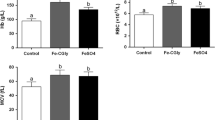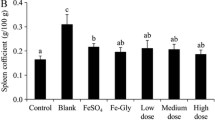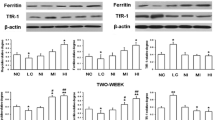Abstract
Iron deficiency is a leading cause of anemia. Amino acids are known to promote the absorption of both soluble and insoluble iron. The bioavailability of organic iron is higher than that of inorganic iron. Therefore, the aim of this study was to evaluate the iron absorption of glycine-bound iron (an organic iron) and a combination of glycine-bound iron and gamma aminobutyric acid (GABA) in mice with iron deficiency anemia (IDA). Mice were fed an iron-deficient diet for 3 weeks, followed by oral administration of GABA, inorganic iron, glycine-bound iron, or GABA plus glycine-bound iron for 5 weeks. Ferritin storage in the spleen was measure by immunohistochemistry (IHC). Iron deposition in the liver and spleen tissues was analyzed using atomic absorption spectrometry. Expression levels of iron absorption-related genes were measured by quantitative real-time polymerase chain reaction (qPCR). Iron absorption was enhanced in the glycine-bound iron-treated group compared with the inorganic iron-treated group. Hemoglobin, serum Fe, ferritin, and liver iron levels did not increase in mice treated with GABA alone. However, mice administered GABA in combination with glycine-bound iron showed higher iron absorption than those administered organic iron alone. Our results indicate that glycine-bound iron in combination with GABA might exert a synergistic effect on iron absorption and bioavailability, suggesting that the addition of GABA to existing iron supplements might increase their effectiveness for treating IDA.




Similar content being viewed by others
References
Andrews NC (2000) Iron metabolism: iron deficiency and iron overload. Annu Rev Genomics Hum Genet 1:75–98
Kassebaum NJ (2016) The global burden of anemia. Hematol Oncol Clin North Am 30:247–308
Kassebaum NJ, Jasrasaria R, Naghavi M, Wulf SK, Johns N, Lozano R, Regan M, Weatherall D, Chou DP, Eisele TP et al (2014) A systematic analysis of global anemia burden from 1990 to 2010. Blood 123:615–624
WHO (2015) The global prevalence of anaemia in 2011. World Health Organization, Geneva
Papanikolaou G, Pantopoulos K (2005) Iron metabolism and toxicity. Toxicol Appl Pharmacol 202:199–211
Ugwuja E, Akubugwo E, Ibiam U, Onyechi O (2010) Impact of maternal iron deficiency and anaemia on pregnancy and its outcomes in a Nigerian population. Internet J Nutr Wellness 10:1–11
Morgan EH, Oates PS (2002) Mechanisms and regulation of intestinal iron absorption. Blood Cells Mol Dis 29:384–399
Conrad ME, Umbreit JN (2000) Iron absorption and transport—an update. Am J Hematol 64:287–298
Miret S, Simpson RJ, McKie AT (2003) Physiology and molecular biology of dietary iron absorption. Annu Rev Nutr 23:283–301
Glahn RP, Van Campen DR (1997) Iron uptake is enhanced in Caco-2 cell monolayers by cysteine and reduced cysteinyl glycine. J Nutr 127:642–647
Li Y, Jiang H, Huang G (2017) Protein hydrolysates as promoters of non-Haem Iron absorption. Nutrients 9:609
Kegley E, Spears J, Flowers W, Schoenherr W (2002) Iron methionine as a source of iron for the neonatal pig1. Nutr Res 22:1209–1217
Roussel G, Stevens V, Cottin S, McArdle HJ (2017) The effect of amino acid deprivation on the transfer of iron through Caco-2 cell monolayers. J Trace Elem Med Biol 40:82–90
Ettle T, Schlegel P, Roth F (2008) Investigations on iron bioavailability of different sources and supply levels in piglets. J Anim Physiol Anim Nutr 92:35–43
Jakobs C, Jaeken J, Gibson K (1993) Inherited disorders of GABA metabolism. J Inherit Metab Dis 16:704–715
Park KB, Oh SH (2007) Cloning, sequencing and expression of a novel glutamate decarboxylase gene from a newly isolated lactic acid bacterium, Lactobacillus brevis OPK-3. Bioresour Technol 98:312–319
Komatsuzaki N, Shima J, Kawamoto S, Momose H, Kimura T (2005) Production of γ-aminobutyric acid (GABA) by Lactobacillus paracasei isolated from traditional fermented foods. Food Microbiol 22:497–504
Wong T, Guin C, Bottiglieri T, Snead OC (2003) Gaba, γ-hydroxybutyric acid, and neurological disease. Ann Neurol 54:3–12
Trenkwalder C, Winkelmann J, Inoue Y, Paulus W (2015) Restless legs syndrome-current therapies and management of augmentation. Nat Rev Neurol 11:434–445
Lyu S, DeAndrade MP, Mueller S, Oksche A, Walters AS, Li Y (2019) Hyperactivity, dopaminergic abnormalities, iron deficiency and anemia in an in vivo opioid receptors knockout mouse: implications for the restless legs syndrome. Behav Brain Res 374:112123
Moreno-Fernandez J, Lopez-Aliaga I, Garcia-Burgos M, Alferez MJM, Diaz-Castro J (2019) Fermented goat milk consumption enhances brain molecular functions during Iron deficiency anemia recovery. Nutrients 11:E2394
Beard J (2003) Iron deficiency alters brain development and functioning. J Nutr 133:1468S–1472S
Barrett E, Ross R, O'toole P, Fitzgerald G, Stanton C (2012) γ-Aminobutyric acid production by culturable bacteria from the human intestine. J Appl Microbiol 113:411–417
Kinnersley AM, Turano FJ (2000) Gamma aminobutyric acid (GABA) and plant responses to stress. Crit Rev Plant Sci 19:479–509
Janik R, Thomason LAM, Stanisz AM, Forsythe P, Bienenstock J, Stanisz GJ (2016) Magnetic resonance spectroscopy reveals oral Lactobacillus promotion of increases in brain GABA, N-acetyl aspartate and glutamate. Neuroimage 125:988–995
Wu Q, Shah NP (2017) High γ-aminobutyric acid production from lactic acid bacteria: emphasis on Lactobacillus brevis as a functional dairy starter. Crit Rev Food Sci Nutr 57:3661–3672
Kim YM, Lee KH, Kim DY, Kang BS, Yoon JS, Lee YB, Jeong JH, Nam SY, Yun YW, Kim JS (2012) Effect of iron-nanoparticles and ironmicroparticles on erythropoiesis and iron-storage in iron-deficiency anemic mice. J Biomed Res 13:119–132
Livak KJ, Schmittgen TD (2001) Analysis of relative gene expression data using real-time quantitative PCR and the 2(−Delta Delta C(T)) method. Methods 25:402–408
Shi Z, Hu X, Yuan B, Pan X, Meyer HE, Holmboe-Ottesen G (2006) Association between serum ferritin, hemoglobin, iron intake, and diabetes in adults in Jiangsu, China. Diabetes Care 29:1878–1883
Chen MH, Su TP, Chen YS, Hsu JW, Huang KL, Chang WH, Chen TJ, Bai YM (2013) Association between psychiatric disorders and iron deficiency anemia among children and adolescents: a nationwide population-based study. BMC Psychiatry 13:161
Thirupathi A, Chang YZ (2019) Brain iron metabolism and CNS diseases. Adv Exp Med Biol 1173:1–19
Sipe JC, Lee P, Beutler E (2002) Brain iron metabolism and neurodegenerative disorders. Dev Neurosci 24:188–196
Shukla A, Agarwal KN, Shukla GS (1989) Latent iron deficiency alters gamma-aminobutyric acid and glutamate metabolism in rat brain. Experientia 45:343–345
Hill JM (1985) Iron concentration reduced in ventral pallidum, globus pallidus, and substantia nigra by GABA-transaminase inhibitor, gamma-vinyl GABA. Brain Res 342:18–25
Finch CA, Hegsted M, Kinney TD, Thomas E, Rath CE, Haskins D, Finch S, Fluharty RG (1950) Iron metabolism: the pathophysiology of iron storage. Blood 5:983–1008
Cook JD (2005) Diagnosis and management of iron-deficiency anaemia. Best Pract Res Clin Haematol 18:319–332
Conrad ME, Crosby WH, Merrill B (1963) Intestinal mucosal mechanisms controlling iron absorption. Blood 22:406–415
Haq SM (2009) Anemia analyzer: algorithm and reflex testing in clinical practice leading to efficiency and cost savings. Stud Health Technol Inform 143:14–16
Sinha N, Mishra T, Singh T, Gupta N (2012) Effect of iron deficiency anemia on hemoglobin A1c levels. Ann Lab Med 32:17–22
Evans TC, Jehle D (1991) The red blood cell distribution width. J Emerg Med 9:71–74
Gunshin H, Mackenzie B, Berger UV, Gunshin Y, Romero MF, Boron WF, Nussberger S, Gollan JL, Hediger MA (1997) Cloning and characterization of a mammalian proton-coupled metal-ion transporter. Nature 388:482–488
Lane DJ, Merlot AM, Huang ML, Bae DH, Jansson PJ, Sahni S, Kalinowski DS, Richardson DR (2015) Cellular iron uptake, trafficking and metabolism: key molecules and mechanisms and their roles in disease. Biochim Biophys Acta 1853:1130–1144
Funding
This work was fully financially supported by the Ministry of Agriculture, Food, and Rural Affairs (MAFRA) through the Agri-Bio Industry Technology Development Project, funded by the Korea Institute of Planning and Evaluation for Technology in Food, Agriculture, and Forestry (IPET) (116084).
Author information
Authors and Affiliations
Corresponding author
Ethics declarations
Conflict of Interests
The authors declare that they have no conflict of interests.
Additional information
Publisher’s Note
Springer Nature remains neutral with regard to jurisdictional claims in published maps and institutional affiliations.
Rights and permissions
About this article
Cite this article
Park, KT., Sim, I., Ko, HS. et al. Gamma Aminobutyric Acid Increases Absorption of Glycine-Bound Iron in Mice with Iron Deficiency Anemia. Biol Trace Elem Res 197, 628–638 (2020). https://doi.org/10.1007/s12011-020-02027-9
Received:
Accepted:
Published:
Issue Date:
DOI: https://doi.org/10.1007/s12011-020-02027-9




